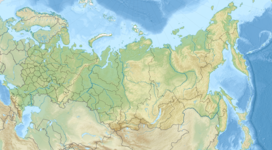Udina (Russian: Удина) is a volcanic massif located in the central part of the Kamchatka Peninsula, Russia. It comprises two distinct conical stratovolcanoes: Bolshaya Udina, standing at 2,920 meters, and Malaya Udina, with a height of 1,945 meters.
| Udina | |
|---|---|
 in 2020 | |
| Highest point | |
| Elevation | 2,920 m (9,580 ft)[1] |
| Prominence | 1,630 m (5,350 ft)[1] |
| Listing | Ultra |
| Coordinates | 55°45′30″N 160°31′36″E / 55.75833°N 160.52667°E[1] |
| Geography | |
| Location | Kamchatka, Russia |
| Parent range | Eastern Range |
| Geology | |
| Mountain type | Stratovolcanoes |
| Last eruption | Unknown |
Malaya Udina, the smaller of the two, is a basaltic volcano located at the eastern end of the complex, rising above a low saddle. Its flanks are dotted with small lava domes, characteristic of its formation. [2] This volcano is part of the Volcanoes of Kamchatka, a UNESCO World Heritage site, recognized for its geological significance and natural beauty.
Bolshaya Udina, the larger and western volcano, is composed primarily of andesitic rock and features a prominent lava dome on its southwestern flank. Although it was long considered extinct, Bolshaya Udina surprised the scientific community when it exhibited signs of seismic activity, leading to its reclassification as an 'active' volcano in June 2019.[3] This reawakening has drawn attention to the potential hazards associated with the volcano, as well as the dynamic nature of the region's volcanic activity.
View
editSee also
editReferences
edit- ^ a b c "Russia: Kamchatka and the Russian Pacific Islands" Peaklist.org. Retrieved 24 March 2013.
- ^ "Udina". Global Volcanism Program. Smithsonian Institution. Retrieved 2021-06-25.
- ^ Dixon, Emily (7 June 2019). "Extinct volcano has woken up and scientists say it could erupt 'at any moment'". CNN. Retrieved 8 June 2019.
- ^ "Activity at Klyuchevskoy Volcano". earthobservatory.NASA.gov. 2 December 2013. Retrieved 10 June 2019.
External links
edit- "Mount Bolshaya Udina, Russia". Peakbagger.com.
